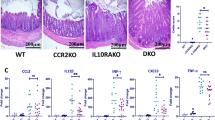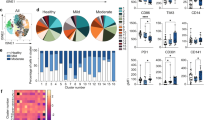Abstract
Monocytes recruited to tissues mediate defense against microbes or contribute to inflammatory diseases. Regulation of the number of circulating monocytes thus has implications for disease pathogenesis. However, the mechanisms controlling monocyte emigration from the bone marrow niche where they are generated remain undefined. We demonstrate here that the chemokine receptor CCR2 was required for emigration of Ly6Chi monocytes from bone marrow. Ccr2−/− mice had fewer circulating Ly6Chi monocytes and, after infection with Listeria monocytogenes, accumulated activated monocytes in bone marrow. In blood, Ccr2−/− monocytes could traffic to sites of infection, demonstrating that CCR2 is not required for migration from the circulation into tissues. Thus, CCR2-mediated signals in bone marrow determine the frequency of Ly6Chi monocytes in the circulation.
This is a preview of subscription content, access via your institution
Access options
Subscribe to this journal
Receive 12 print issues and online access
$209.00 per year
only $17.42 per issue
Buy this article
- Purchase on SpringerLink
- Instant access to full article PDF
Prices may be subject to local taxes which are calculated during checkout






Similar content being viewed by others
References
Cyster, J.G. Lymphoid organ development and cell migration. Immunol. Rev. 195, 5–14 (2003).
Lapidot, T. & Petit, I. Current understanding of stem cell mobilization: the roles of chemokines, proteolytic enzymes, adhesion molecules, cytokines, and stromal cells. Exp. Hematol. 30, 973–981 (2002).
Nagasawa, T., Kikutani, H. & Kishimoto, T. Molecular cloning and structure of a pre-B-cell growth-stimulating factor. Proc. Natl. Acad. Sci. USA 91, 2305–2309 (1994).
Bleul, C.C., Fuhlbrigge, R.C., Casasnovas, J.M., Aiuti, A. & Springer, T.A. A highly efficacious lymphocyte chemoattractant, stromal cell-derived factor 1 (SDF-1). J. Exp. Med. 184, 1101–1109 (1996).
Peled, A. et al. The chemokine SDF-1 activates the integrins LFA-1, VLA-4, and VLA-5 on immature human CD34+ cells: role in transendothelial/stromal migration and engraftment of NOD/SCID mice. Blood 95, 3289–3296 (2000).
Shen, H. et al. CXCR-4 desensitization is associated with tissue localization of hemopoietic progenitor cells. J. Immunol. 166, 5027–5033 (2001).
Hidalgo, A. et al. Chemokine stromal cell-derived factor-1α modulates VLA-4 integrin-dependent adhesion to fibronectin and VCAM-1 on bone marrow hematopoietic progenitor cells. Exp. Hematol. 29, 345–355 (2001).
Hernandez, P.A. et al. Mutations in the chemokine receptor gene CXCR4 are associated with WHIM syndrome, a combined immunodeficiency disease. Nat. Genet. 34, 70–74 (2003).
Gorlin, R.J. et al. WHIM syndrome, an autosomal dominant disorder: clinical, hematological, and molecular studies. Am. J. Med. Genet. 91, 368–376 (2000).
Geissmann, F., Jung, S. & Littman, D.R. Blood monocytes consist of two principal subsets with distinct migratory properties. Immunity 19, 71–82 (2003).
Luther, S.A. & Cyster, J.G. Chemokines as regulators of T cell differentiation. Nat. Immunol. 2, 102–107 (2001).
Kurihara, T., Warr, G., Loy, J. & Bravo, R. Defects in macrophage recruitment and host defense in mice lacking the CCR2 chemokine receptor. J. Exp. Med. 186, 1757–1762 (1997).
Sato, N. et al. CC chemokine receptor (CCR)2 is required for langerhans cell migration and localization of T helper cell type 1 (Th1)-inducing dendritic cells: absence of CCR2 shifts the Leishmania major-resistant phenotype to a susceptible state dominated by Th2 cytokines, B cell outgrowth, and sustained neutrophilic inflammation. J. Exp. Med. 192, 205–218 (2000).
Peters, W. et al. Chemokine receptor 2 serves an early and essential role in resistance to Mycobacterium tuberculosis. Proc. Natl. Acad. Sci. USA 98, 7958–7963 (2001).
Held, K.S., Chen, B.P., Kuziel, W.A., Rollins, B.J. & Lane, T.E. Differential roles of CCL2 and CCR2 in host defense to coronavirus infection. Virology 329, 251–260 (2004).
Hokeness, K.L., Kuziel, W.A., Biron, C.A. & Salazar-Mather, T.P. Monocyte chemoattractant protein-1 and CCR2 interactions are required for IFN-α/β-induced inflammatory responses and antiviral defense in liver. J. Immunol. 174, 1549–1556 (2005).
Robben, P.M., Laregina, M., Kuziel, W.A. & Sibley, L.D. Recruitment of Gr-1+ monocytes is essential for control of acute toxoplasmosis. J. Exp. Med. 201, 1761–1769 (2005).
Boring, L., Gosling, J., Cleary, M. & Charo, I.F. Decreased lesion formation in CCR2−/− mice reveals a role for chemokines in the initiation of atherosclerosis. Nature 394, 894–897 (1998).
Izikson, L., Klein, R.S., Charo, I.F., Weiner, H.L. & Luster, A.D. Resistance to experimental autoimmune encephalomyelitis in mice lacking the CC chemokine receptor (CCR)2. J. Exp. Med. 192, 1075–1080 (2000).
Fife, B.T., Huffnagle, G.B., Kuziel, W.A. & Karpus, W.J. CC chemokine receptor 2 is critical for induction of experimental autoimmune encephalomyelitis. J. Exp. Med. 192, 899–905 (2000).
Ross, G.D. Regulation of the adhesion versus cytotoxic functions of the Mac-1/CR3/αMβ2-integrin glycoprotein. Crit. Rev. Immunol. 20, 197–222 (2000).
Colonna, M., Trinchieri, G. & Liu, Y.J. Plasmacytoid dendritic cells in immunity. Nat. Immunol. 5, 1219–1226 (2004).
Lagasse, E. & Weissman, I.L. Flow cytometric identification of murine neutrophils and monocytes. J. Immunol. Methods 197, 139–150 (1996).
Serbina, N., Salazar-Mather, T.P., Biron, C., Kuziel, W.A. & Pamer, E.G. TNF/iNOS-producing dendritic cells mediate innate immune defense against bacterial infection. Immunity 19, 59–70 (2003).
Serbina, N.V. et al. Sequential MyD88-independent and -dependent activation of innate immune responses to intracellular bacterial infection. Immunity 19, 891–901 (2003).
Fleming, T.J., Fleming, M.L. & Malek, T.R. Selective expression of Ly-6G on myeloid lineage cells in mouse bone marrow. RB6–8C5 mAb to granulocyte-differentiation antigen (Gr-1) detects members of the Ly-6 family. J. Immunol. 151, 2399–2408 (1993).
Bruno, L., Seidl, T. & Lanzavecchia, A. Mouse pre-immunocytes as non-proliferating multipotent precursors of macrophages, interferon-producing cells, CD8α+ and CD8α− dendritic cells. Eur. J. Immunol. 31, 3403–3412 (2001).
Taylor, P.R., Brown, G.D., Geldhof, A.B., Martinez-Pomares, L. & Gordon, S. Pattern recognition receptors and differentiation antigens define murine myeloid cell heterogeneity ex vivo. Eur. J. Immunol. 33, 2090–2097 (2003).
Muraille, E. et al. Distinct in vivo dendritic cell activation by live versus killed Listeria monocytogenes. Eur. J. Immunol. 35, 1463–1471 (2005).
Ueda, Y., Yang, K., Foster, S.J., Kondo, M. & Kelsoe, G. Inflammation controls B lymphopoiesis by regulating chemokine CXCL12 expression. J. Exp. Med. 199, 47–58 (2004).
Nagaoka, H., Gonzalez-Aseguinolaza, G., Tsuji, M. & Nussenzweig, M.C. Immunization and infection change the number of recombination activating gene (RAG)-expressing B cells in the periphery by altering immature lymphocyte production. J. Exp. Med. 191, 2113–2120 (2000).
Rot, A. & von Andrian, U.H. Chemokines in innate and adaptive host defense: basic chemokinese grammar for immune cells. Annu. Rev. Immunol. 22, 891–928 (2004).
Huo, Y. et al. The chemokine KC, but not monocyte chemoattractant protein-1, triggers monocyte arrest on early atherosclerotic endothelium. J. Clin. Invest. 108, 1307–1314 (2001).
Legler, D.F. et al. B cell-attracting chemokine 1, a human CXC chemokine expressed in lymphoid tissues, selectively attracts B lymphocytes via BLR1/CXCR5. J. Exp. Med. 187, 655–660 (1998).
Ansel, K.M. et al. A chemokine-driven positive feedback loop organizes lymphoid follicles. Nature 406, 309–314 (2000).
Reif, K. et al. Balanced responsiveness to chemoattractants from adjacent zones determines B-cell position. Nature 416, 94–99 (2002).
Hargreaves, D.C. et al. A coordinated change in chemokine responsiveness guides plasma cell movements. J. Exp. Med. 194, 45–56 (2001).
Dieu, M.C. et al. Selective recruitment of immature and mature dendritic cells by distinct chemokines expressed in different anatomic sites. J. Exp. Med. 188, 373–386 (1998).
Rollins, B.J. Chemokines. Blood 90, 909–928 (1997).
Yoshimura, T. et al. Purification and amino acid analysis of two human glioma-derived monocyte chemoattractants. J. Exp. Med. 169, 1449–1459 (1989).
Auerbuch, V., Brockstedt, D.G., Meyer-Morse, N., O'Riordan, M. & Portnoy, D.A. Mice lacking the type I interferon receptor are resistant to Listeria monocytogenes. J. Exp. Med. 200, 527–533 (2004).
Vallance, P. & Leiper, J. Blocking NO synthesis: how, where and why? Nat. Rev. Drug Discov. 1, 939–950 (2002).
Palladino, M.A., Bahjat, F.R., Theodorakis, E.A. & Moldawer, L.L. Anti-TNF-α therapies: the next generation. Nat. Rev. Drug Discov. 2, 736–746 (2003).
Deo, R. et al. Association among plasma levels of monocyte chemoattractant protein-1, traditional cardiovascular risk factors, and subclinical atherosclerosis. J. Am. Coll. Cardiol. 44, 1812–1818 (2004).
Gosling, J. et al. MCP-1 deficiency reduces susceptibility to atherosclerosis in mice that overexpress human apolipoprotein B. J. Clin. Invest. 103, 773–778 (1999).
Gu, L. et al. Absence of monocyte chemoattractant protein-1 reduces atherosclerosis in low density lipoprotein receptor-deficient mice. Mol. Cell 2, 275–281 (1998).
Takahashi, K. et al. Adiposity elevates plasma MCP-1 levels leading to the increased CD11b-positive monocytes in mice. J. Biol. Chem. 278, 46654–46660 (2003).
Charo, I.F. & Taubman, M.B. Chemokines in the pathogenesis of vascular disease. Circ. Res. 95, 858–866 (2004).
Kuziel, W.A. et al. Severe reduction in leukocyte adhesion and monocyte extravasation in mice deficient in CC chemokine receptor 2. Proc. Natl. Acad. Sci. USA 94, 12053–12058 (1997).
Lu, B. et al. Abnormalities in monocyte recruitment and cytokine expression in monocyte chemoattractant protein 1-deficient mice. J. Exp. Med. 187, 601–608 (1998).
Acknowledgements
Supported by the National Institutes for Health (E.G.P.).
Author information
Authors and Affiliations
Corresponding author
Ethics declarations
Competing interests
The authors declare no competing financial interests.
Supplementary information
Supplementary Fig. 1
Retained monocytes in bone marrow of infected Ccr2−/− mice express myeloid marker 7/4. (PDF 31 kb)
Supplementary Fig. 2
Ccr2−/− monocyte migration from the bloodstream to infected spleen. (PDF 57 kb)
Rights and permissions
About this article
Cite this article
Serbina, N., Pamer, E. Monocyte emigration from bone marrow during bacterial infection requires signals mediated by chemokine receptor CCR2. Nat Immunol 7, 311–317 (2006). https://doi.org/10.1038/ni1309
Received:
Accepted:
Published:
Issue Date:
DOI: https://doi.org/10.1038/ni1309



